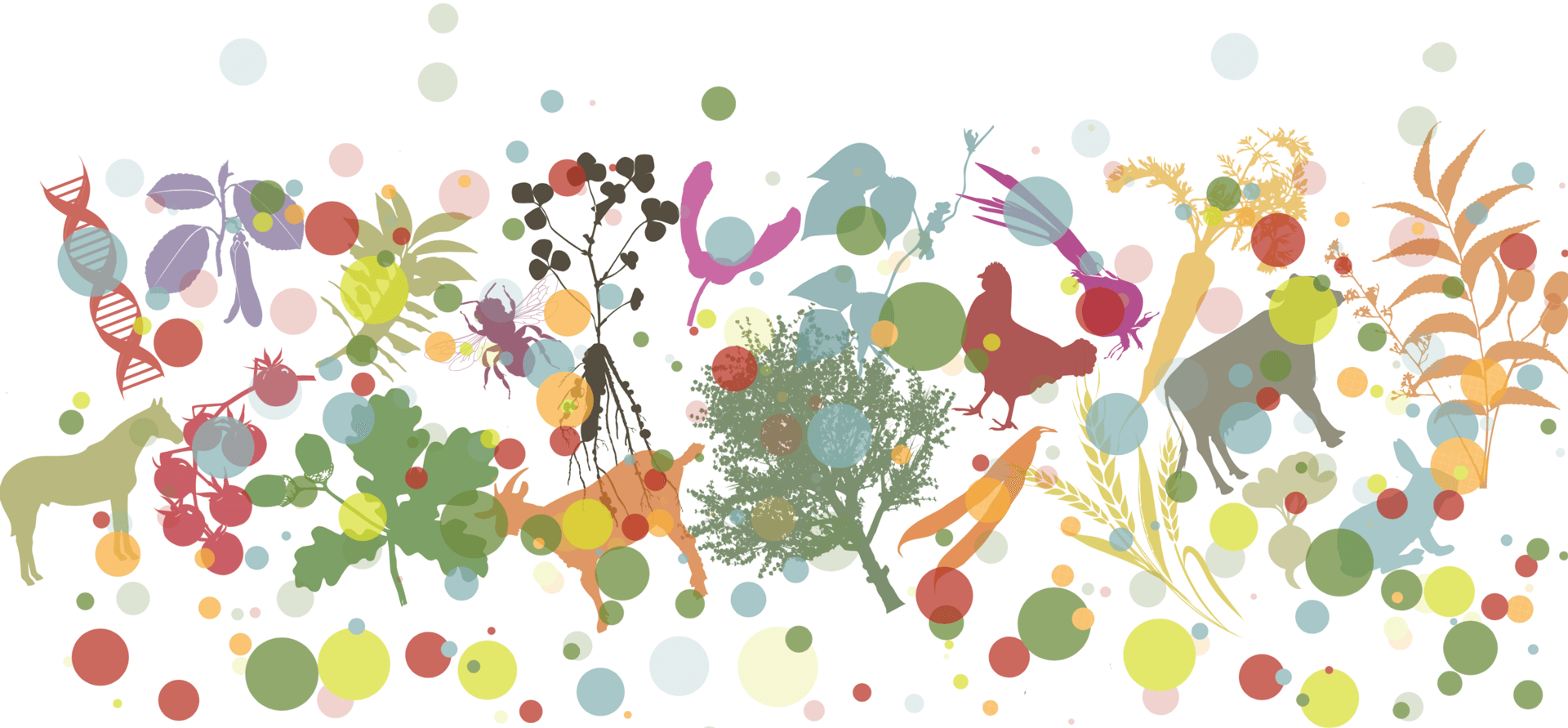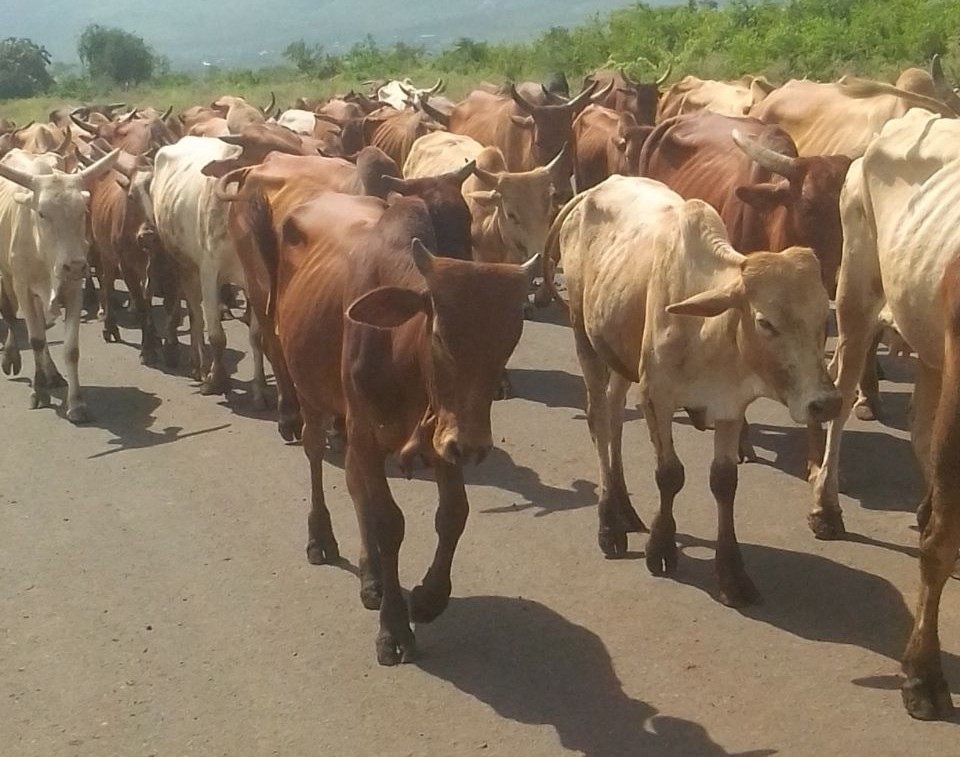Phenotypic characterization of cattle breeds in Southern Ethiopia: Implications for breed differentiation and conservation
Main Article Content
Abstract
This study aimed to characterize and quantify the phenotypic relationship between Gamo and Gofa cattle breeds using nine morphometric measurements and 11 morphological traits. A total of 600 adult cattle (486 females and 114 males) were randomly selected from six purposively chosen districts. Univariate and multivariate analyses were conducted using Statistical Analysis Software. The univariate analysis revealed the morphometric values and morphological characteristics of both cattle breeds but did not show significant variations between them. The majority of the cattle exhibited uniformly patterned coat colour, upward-oriented, straight-shaped horns with black colour, laterally oriented ears with rounded edges, straight face profiles, small hump sizes, short coat hair, and medium tail length. In accordance with the phenotypic similarities observed in the univariate analysis, multivariate analysis also failed to identify significant differences between the two breeds. These results suggest that the two cattle breeds are phenotypically inseparable. However, these phenotypic similarities do not necessarily indicate genetic similarities. Therefore, further genetic characterization is recommended to assess the degree of genetic relationship between the breeds. In the meantime, it is advised to design breed-specific in situ conservation and genetic improvement programmes without separating the cattle breeds.
Article Details

This work is licensed under a Creative Commons Attribution 4.0 International License.
Authors retain copyright of the articles published in Genetic Resources and grant the journal right of first publication with open access. All articles published in Genetic Resource are licensed under Creative Commons Attribution 4.0 International License (CC BY 4.0) that allows others to download, share and adapt the work for commercial and non-commercial purposes as long as proper attribution to the original article is given. Genetic Resources permits and encourages authors to post items submitted to the journal (including the publisher's final layout) on personal websites or institutional repositories after acceptance and/or publication, while providing bibliographic details that credit their publication in Genetic Resources.
Baneh, H and S H Hafezian (2009). “Effect of environmental factor on growth traits in Ghezel sheep”. African Journal of Bio-technology 8, pp. 2903–2907. URL: https://www.ajol.info/index.php/ajb/article/view/60943.
Bekele, D T (2015). On-farm phenotypic characterization of indigenous cattle and their production systems in Bako Tibe and Gobu Sayo districts of Oromia Region, Ethiopia. MSc thesis, Haramaya University, Haramaya, Ethiopia.
Chankalo, T H (2022). “Species composition and relative abundance of medium and large-sized mammals in Woyde Woshe Community Reserve forest areas”. Journal of Ecology and The Natural Environment 13(1), pp. 1–8. URL: https://academicjournals.org/journal/JENE/article-in-press-abstract/species_composition_and_relative_abundance_of_medium_and_large_sized_mammals_in_woyde_woshe_community_reserve_forest_areas_kucha_alpha_woreda_gamo_zone_southern_ethiopia.
Chebo, C, W Ayalew, and Z Wuletaw (2013). “On-farm phenotypic characterization of indigenous cattle populations of Gamo Goffa zone, Southern Ethiopia”. Animal Genetic Resource Information Bulletin 52, pp. 71–82. DOI: https://doi.org/10.1017/S207863361200046X. DOI: https://doi.org/10.1017/S207863361200046X
Cholo, T C et al. (2018). “s Land Fragmentation Facilitating or Obstructing Adoption of Climate Adaptation Measures in Ethiopia?” Sustainability 10(2120). DOI: https://doi.org/10.3390/su10072120. DOI: https://doi.org/10.3390/su10072120
Chriha, A and G Ghadri (2001). Caprine in the Arab world. 2. ed. Department of Livestock Production. Fateh University: Libby Conservation of Biodiversity and Environments in the Arab Countries, p. 478.
CSA (2022). Agricultural Sample Survey 2021/22 (2014 E.C). Report on Livestock and Livestock Characteristics Statistical Bulletin No. 594. Vol. II. Addis Ababa, Ethiopia: Federal Democratic Republic of Ethiopia Central Statistical Agency, p. 219.
EBI (2016). Ethiopian National Strategy and Plan of Action for conservation and utilization of Animal Genetic Resources. URL: https://www.ebi.gov.et/wp-content/uploads/2021/10/Ethiopian-National-Strategy-and-Plan-of-Action-for-Conservation-Sustainable-Use-and-Development-of-Animal-Genetic-Resources-.pdf.
Falconer, D S (1989). Introduction to Quantitative Genetics. 3rd. New York: Longman, p. 438. FAO (2012). Phenotypic characterization of animal genetic resources. FAO Animal Production and Health Guidelines number 11. Rome: FAO. URL: https://www.fao.org/3/a1404e/a1404e.pdf.
Ftiwi, M (2015). Production system and phenotypic characterization of Begait cattle, and effects of supplementation with concentrate feeds on milk yield and composition of Begait cows in Humera ranch, Western Tigray, Ethiopia. Debre Zeit, Ethiopia.
Gegnaw, S T and T T Hadado (2014). “Genetic diversity of qualitative traits of barley (Hordeum Vulgare L.) landrace populations collected from Gamo Highlands of Ethiopia”. International Journal of Biodiversity and Conservation 6(9), pp. 663–673. DOI: https://doi.org/10.5897/IJBC2014.0718. DOI: https://doi.org/10.5897/IJBC2014.0718
Genzebu, D, M Hailemariam, and K Belihu (2012). “Morphometric characteristics and livestock keeper perceptions of “Arado” cattle breed in Northern Tigray, Ethiopia”. Livestock Research for Rural Development 24(6). URL: https://www.lrrd.org/lrrd24/1/hail24006.htm.
Getachew, F K and W Ayalew (2014). “On-farm phenotypic characterization of indigenous cattle populations of Awi, East and West Gojjam Zones of Amhara Region”. Ethiopia. Research Journal of Agriculture and Environmental Management 3(4), pp. 227–237.
Getachew, F, S Abegaz, et al. (2014). “On-farm phenotypic characterization of Ogaden cattle populations of Jigjiga zone, southeastern Ethiopia”. Ethiopian Journal of Animal Production 14, pp. 66–83. URL: https://www.researchgate.net/publication/325011260_On-farm_phenotypic_characterization_of_Ogaden_cattle_populations_of_Jigjiga_zone_southeastern_Ethiopia.
Getachew, F, A Assefa, et al. (2020). “On-Farm phenotypic characterization of Begaria cattle population and their production system in Guba district”. Ethiopian Journal of Animal Production 20(1), pp. 1–17. URL: https://www.researchgate.net/publication/349625372_On-Farm_Phenotypic_Characterization_of_Begaria_Cattle_Population_and_Their_Production_System_in_Guba_District_North_Western_Ethiopia.
Girma, E et al. (2016). “Phenotypic characterization, population structure, breeding management and recommend breeding strategy for Fogera cattle (Bos indicus) in Northwestern Amhara, Ethiopia”. Animal Genetic Resources 58, pp. 13–29. DOI: https://doi.org/10.1017/S2078633616000035. DOI: https://doi.org/10.1017/S2078633616000035
Kassa, G et al. (2022). “Above- and belowground biomass and biomass carbon stocks in home garden agroforestry systems of different age groups at three sites of southern and southwestern Ethiopia”. Carbon Management 13(1), pp. 531–549. DOI: https://doi.org/10.1080/17583004.2022.2133743. DOI: https://doi.org/10.1080/17583004.2022.2133743
Kebede, H et al. (2017). “Characterization of Gofa cattle population, production system, production and reproduction performance in Southern Ethiopia”. Journal of Fisheries and Livestock Production 5(3), p. 237. DOI: http://doi.org/10.4172/2332-2608.1000237. DOI: https://doi.org/10.4172/2332-2608.1000237
Kramer, C Y (1956). “Extension of Multiple Range Tests to Group Means with Unequal Number of Replications”. Biometrics 12, pp. 307–310. DOI: https://doi.org/10.2307/3001469. DOI: https://doi.org/10.2307/3001469
Leulalem, S B et al. (2016). “Groundwater Investigation for Domestic Purpose Zala Woreda”. International Journal of Engineering Science and Computing 6(7), pp. 1869–1881. URL: https://www.researchgate.net/publication/321392194_Groundwater_Investigation_for_Domestic_Purpose_Zala_Woreda_Gamo_Gofa_Zone_Southern_Ethiopia.
Minuye, N, G Abebe, and T Dessie (2018). “On-farm description and status of Nuer (Abigar) cattle breed in Gambella Regional State, Ethiopia”. International Journal of Biodiversity and Conservation 10(6), pp. 292–302. DOI: https://doi.org/10.5897/IJBC2017.1168. DOI: https://doi.org/10.5897/IJBC2017.1168
Mustefa, A (2023). “Implication of phenotypic and molecular characterization to breed differentiation of Ethiopian cattle. A review”. Ecological Genetics and Genomics 29(100208). DOI: https://doi.org/10.1016/j.egg.2023.100208. DOI: https://doi.org/10.1016/j.egg.2023.100208
Mustefa, A, T Aseged, et al. (2023). “Phenotypic diversity between and within Harar and Ogaden cattle breeds in eastern Ethiopia: The first step for conservation”. Genetic Resources 4(7), pp. 56–67. DOI: https://doi.org/10.46265/genresj.IXPJ9541. DOI: https://doi.org/10.46265/genresj.IXPJ9541
Mustefa, A, T Belayhun, et al. (2021). “Phenotypic characterization of Raya cattle in northern Ethiopia”. Tropical Animal Health and Production 53(48). DOI: https://doi.org/10.1007/s11250-020-02486-1. DOI: https://doi.org/10.1007/s11250-020-02486-1
Nigatu, Y M and Y Tadesse (2020). “Morphological Variations of Arsi, Kereyu and their Crossbred Cattle under current climate change in mid Rift Valley of Oromia, Ethiopia”. Academic Research Journal of Agricultural Science and Research 8(6), pp. 630–648. DOI: http://doi.org/10.14662/ARJASR2020.440.
O Rege, J E (1999). “The state of African cattle genetic resources I. Classification framework and identification of threatened and extinct breeds”. Animal Genetic Resources Information 25, pp. 1–25. DOI: https://doi.org/10.1017/S1014233900003448. DOI: https://doi.org/10.1017/S1014233900003448
O Rege, J E and C L Tawa (1999). “The state of African cattle genetic resources II. Geographical distribution, characteristics and uses of present-day breeds and strains”. Animal Genetic Resources Information 26, pp. 1–25. DOI: https://doi.org/10.1017/S1014233900001152. DOI: https://doi.org/10.1017/S1014233900001152
Rensch, B (1950). “Die Abhangigkeit der relative sexual differenz von der korpergrosse”. Bonner Zoologische Beitrage 1, pp. 58–69. URL: https://www.biodiversitylibrary.org/partpdf/119381.
SAS (2002). Statistical Analysis System. Version 9.0 for windows. SAS Institute Inc., Cary NC, USA. URL: https://www.sas.com/enus/home.html.
Statista (2024). Africa: countries with largest cattle population 2024. URL: https://www.statista.com/statistics/1290046/cattle-population-in-africa-by-country/.
Tadesse, D, W Ayalew, and B P Hegde (2008). “On-farm Phenotypic Characterization of Cattle Genetic Resources in South and North Wollo Zones of Amhara Region”. Ethiopian Journal of Animal Production 8(1), pp. 22–38. URL: https://www.researchgate.net/publication/284724322_On-farm_Phenotypic_Characterization_of_Cattle_Genetic_Resources_in_South_and_North_Wollo_Zones_of_Amhara_Region_North_Eastern_Ethiopia.
Tatum, J D (2011). Animal age, physiological maturity, and associated effects on beef tenderness. White paper Research and Knowledge Management.
Terefe, E et al. (2015). “On-farm phenotypic characterization of Mursi cattle in its production environment in South Omo Zone, Southwest Ethiopia”. Animal Genetic Resources 57, pp. 15–24. DOI: https://doi.org/10.1017/S2078633615000132. DOI: https://doi.org/10.1017/S2078633615000132
W Tukey, J (1953). The problem of multiple comparisons. Unpublished manuscript. Princeton University.
Yimamu, C (2014). In situ phenotypic characterization and production system study of Arsi cattle type in Arsi highland of Oromia Region, Ethiopia. MSc thesis, Haramaya University, Haramaya, Ethiopia.
Zechner, P et al. (2001). “Morphological description of the Lipizzan horse population”. Livestock Production Science 69, pp. 163–177. DOI: https://doi.org/10.1007/s11250-021-02652-z. DOI: https://doi.org/10.1016/S0301-6226(00)00254-2
Zegeye, T, G Belay, and O Hanotte (2021). “Multivariate characterization of phenotypic traits of five native cattle populations from Tigray, Northern Ethiopia”. Tropical Animal Health and Production 53(212). DOI: https://doi.org/10.1007/s11250-021-02652-z. DOI: https://doi.org/10.1007/s11250-021-02652-z
Zeleke, B, M Getachew, and K Worku (2017). “Phenotypic characterization of indigenous cattle populations in Gamo Gofa Zone, Southwestern Ethiopia”. European Journal of Biological Sciences 9(3), pp. 124–130. DOI: http://dx.doi.org/10.5829/idosi.ejbs.2017.124.130.
Zerabruk, M and O Vangen (2005). “The Abergelle and Irob cattle breeds of North Ethiopia: description and on-farm characterization”. Animal Genetic Resources Information Bulletin 36, pp. 7–20. DOI: https://doi.org/10.1017/S101423390000184X. DOI: https://doi.org/10.1017/S101423390000184X







 This journal has been conceived as part of the
This journal has been conceived as part of the